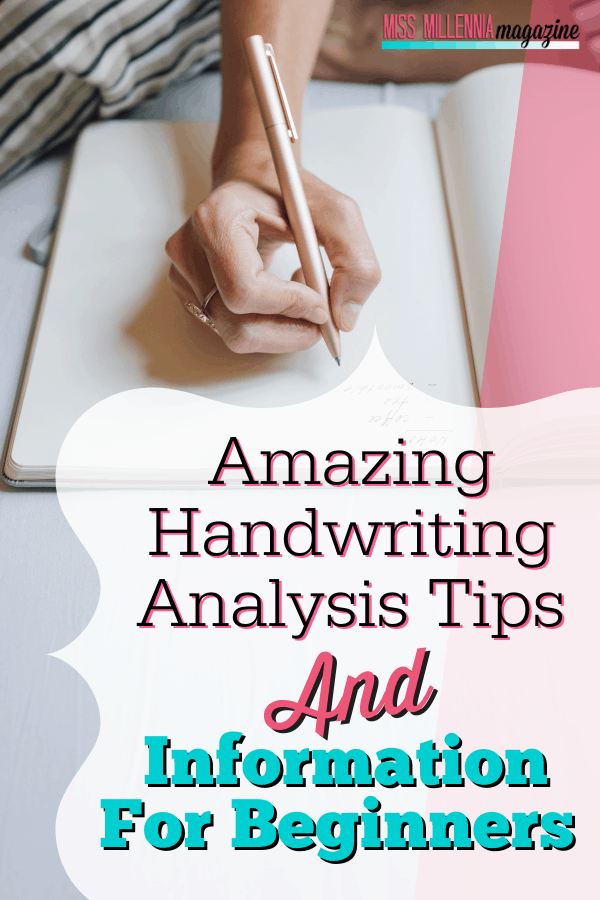Amazing Handwriting Analysis Tips And Information For Beginners
Handwriting analysis is the interpretation of the symbols and strikes in a person’s handwriting to understand their personality better. While it’s not an exact science, you can get much information by analyzing someone’s handwriting. Before you get started as a beginner, you need to review these basic essential handwriting analysis tips and information.
You can tell how a person feels or even some things about their past just from their handwriting. Let’s get started!
Cursive vs. Print
The first of our handwriting tips and information is that you must get a writing sample in cursive.
While you can still tell much about a person from their print writing, there is more of an emotional connection to cursive writing. It allows you to get a more detailed read.
To learn more about the power of cursive penmanship, read The Lost Art Of Handwriting.
Handwriting Analysis Zones
Handwriting analysis, often called graphology, is the study of and interpretation of an individual’s handwriting to get insight into that person’s personality characteristics, emotions, and behavioral patterns. Handwriting analysis consists of several key factors, one of which is the evaluation of the three zones, which are upper, middle, and lower.
It is always good to tell which zone is more dominant in a person’s handwriting.
The dominance of these zones in a person’s handwriting might reveal insightful information about that person’s personality if the writing is analyzed. However, it is essential to remember that the study of handwriting is regarded as pseudoscience by many specialists, and one must approach its conclusions with extreme caution.
Handwriting can be influenced by various factors, including mood, writing style, and other contextual factors; as a result, it might be challenging to draw definitive conclusions based just on the zones.
Upper zone
The upper zone includes letters that touch the top line, such as lowercase` l’s, t’s, and b’s. If their upper area is dominant, then they are probably more of an intellectual or philosophical person.
The upper zone symbolizes the mind, where one’s ideas, intellect, and goals reside. It includes the loops and extensions found in the upper portions of the letters. A person whose handwriting is dominated by the upper zones is likely intellectually minded, visionary, and intent on abstract notions. People like this are typically innovative, creative, and able to find solutions to problems.
Middle Zone
The middle zone includes lowercase letters such as a, e, I, o, and you. If the central area is dominant, that person probably bases many decisions on their emotions. The middle zone is connected to the torso and represents a circle of interpersonal connections, feelings, and social interactions.
It is the main body of the letters and displays how a person communicates their feelings and interacts with other people. It is the most essential part of the letters. A person with a prominent middle zone in their handwriting likely has a social personality, is emotionally expressive, and is sensitive to the dynamics of their interactions. These people are frequently empathetic and friendly and highly emphasize human ties.
Lower Zone
The lower zone consists of all the letters that drop below the lower line, such as lowercase y’s, g’s, q’s, p’s, and j’s. If the lower zone is the most dominant, then that person is probably a physical person. They may be materialistic or have a big sexual appetite.
The lower zone is symbolic of the lower regions of the body, including the erogenous zones and the desires that are governed by instinct. This pertains to the lower loops and the extensions in the letters. A person driven by their body’s physical needs, passions, and sensuality will have handwriting with a dominant bottom zone. They have a propensity to be lively and sensual, and they have a solid connection to the most fundamental aspects of themselves.

Get a better sense of how these three zones aid you in analyzing someone’s handwriting with the book Handwriting Analysis Made Easy!
The Importance of Slant
The slant is also a critical handwriting analysis. It represents how a person relates to other people. There are three slants in handwriting: slant to the left, the right, and up.
Left Slant
When a person’s handwriting is slanted to the left, they tend to be emotionally withdrawn and repressed.
Right Slant
If the writing is slanted to the right, the person can easily connect with others.
Straight Up
When a person’s handwriting slants straight up, the person is most comfortable being independent.
Combination
A combination of slants in a handwriting sample could reveal that a person changes moods quickly. They may be unpredictable when communicating with others. It is usually a dangerous sign when meeting someone new.

Read Handwriting Analysis: The Complete Basic Book to dive deeper into handwriting analysis tips and information.
Amount of Pressure
The amount of pressure someone applies to the paper when they write can provide insight into how easy it is to persuade this person.
The best way to test for pressure is to feel the back of the paper. If you can feel the writing through the other side of the article, it is probably hard to persuade that person if their mind is made up. On the other hand, if the person doesn’t use a lot of pressure, that person can likely be influenced easily.
Size of Writing
There are three basic sizes in handwriting: big, medium, and trim. This can tell many things about a person.
Big
If someone writes in big letters, it usually means that the person is more of a people person and likes socializing. Additionally, they will probably attempt a project by first looking at the big picture and focusing on the details later.
Small
Unsurprisingly, small handwriting indicates the opposite of big handwriting. This person is more of an introvert and keeps to themselves. They approach projects by paying attention to the details first and focusing on the big picture later. A small writer is also more inclined to cozy up in small spaces.
Medium
If a person has medium-sized handwriting, they exist between the two extremes. They can take on any characteristics from smaller and bigger writing.
Please pay attention to changes in someone’s handwriting size, which may indicate how they feel.

Ready for a comprehensive guide to handwriting analysis? Buy The Definitive Book Of Handwriting Analysis!
The Letter “I”
This is the most persuasive letter in the entire alphabet because it represents you as an individual. This letter primarily shows how someone’s relationship is with their mother and father.
There are two loops when the personal pronoun “I” is written in cursive. The loop that touches the top line is the mother loop, and the loop that connects the lower line is the father loop.
This letter has many variations, depending on where the differentiation is and what type.
If no father loop is present, then there is probably no father figure in that person’s life. When the straight line in the father loop is curved, that person lets their dad get away with too many things.
If the mother loop is missing, there was probably no mother figure in that person’s life. On the other hand, if the tip of the mother loop is pointed, there is some aggression towards the mother.
When the two loops touch, that probably means that the mother and father are close.
It is also always good to see which loop is more significant, as that may indicate which parent had a more substantial influence on the individual.
Why is Handwriting analysis critical?
Handwriting analysis, conducted by a handwriting expert or forensic document examiner, is a fascinating field that delves into the study of letterforms, line quality, and other writing characteristics to extract useful information about an individual. From high school students writing notes on unlined paper to examining a ransom note in a criminal investigation, handwriting analysis can uncover individual characteristics, emotional states, and different personality traits.
While forensic handwriting comparison’s scientific basis and reliability remain debatable, the psychological interpretation of handwriting and its inner workings can provide essential insights into a person’s mental health, unusual personality traits, and sexual motivation. It serves as an indispensable tool for forensic science technicians, document examiners, and those in the criminal justice system, aiding in the critical analysis of questioned documents and offering valuable leads in crime scene investigations.
In graphology, the study of human personality through handwriting, the examination of various elements such as the slant, line form, word spacing, and capital letters can offer clues about an individual’s emotional characteristics, mental aptitudes, and even sense of humor. Handwriting analysis extends beyond the forensic sciences, with applications in occupational therapy, where in-hand manipulation skills, dynamic finger movement, and handwriting patterns can be evaluated to guide treatment and improve fine motor skills.
From career guidance to personality assessment, the study of graphology opens up a world of understanding, providing new insights into oneself and others. Whether analyzing the large handwriting and excessive pen lifts of John Hancock or deciphering the legible signature on a blank sheet of paper, handwriting analysis offers a unique and insightful perspective into the intricacies of human behavior and the depths of one’s inner workings.
In short, while handwriting analysis may not possess a concrete scientific evidence base, it remains an intriguing and valuable tool in understanding individuals and their psychological makeup.
Whether used as a forensic analysis service or a personal exploration of one’s handwriting, it offers a helpful glossary of terminology and workbook examples to aid professional analysts and new people interested in the subject. Handwriting analysis provides a means to grasp patterns, interpret writing characteristics, and gain insight into writing speed, line quality, and downward strokes. It has proven to be an indispensable resource in fields ranging from criminal investigation to occupational therapy, showcasing its versatility and relevance.
As long as there is writing on paper, the study of handwriting will continue to be an intriguing and valuable tool for exploring the depths of human personality and uncovering hidden aspects of the self.
Final Thoughts
There are many reasons to take up handwriting analysis as a hobby or a possible career. While this only explains what it is and what to look for, I highly suggest reading more literature on handwriting analysis. Start with the books recommended in this article!
You can also learn more handwriting analysis tips and information by reading our article The Best Dating Advice by Michelle Dresbold!











